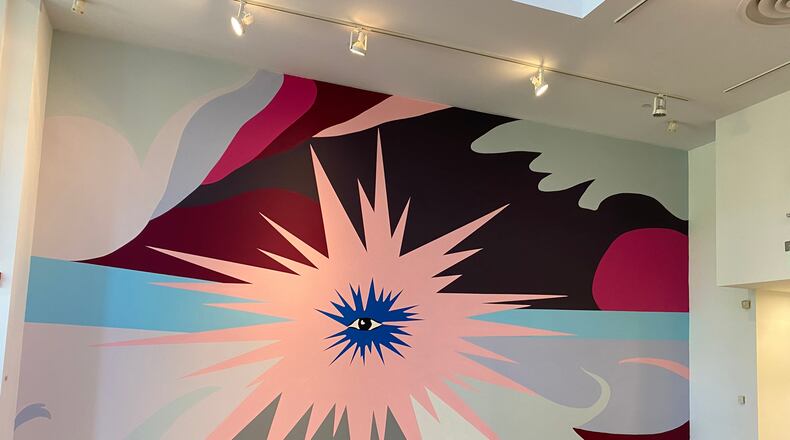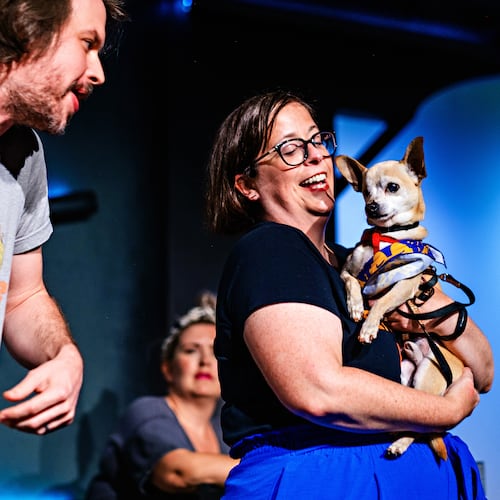Right now, Emory University offers what is probably the most provocative combination of art-history exhibitions in the city. It is almost certainly the most wide-ranging.
Through Dec. 14, the Emory University Visual Arts Gallery is presenting the work of the almost-forgotten musician and visual artist Ayé Aton, in a show titled “Duality.” Aton, who became a percussionist in Sun Ra’s Arkestra in the 1970s after studying philosophy with Sun Ra’s guidance, painted a wide variety of now-lost metaphysically symbolic wall murals in Chicago and Philadelphia. He eventually returned to his native Kentucky in 2016. Over the last two decades of his life, he produced a substantial number of paintings on canvas, board and paper, most of which were never exhibited prior to his death in 2017.
This show was curated by Daniel Fuller, known to many Atlantans from his time as curator at Atlanta Contemporary. It incorporates what little is known about the artist’s biography, information that is also available on a website devoted to Aton’s art, but it poses more questions than it answers.
Exactly how, for example, do the paintings about such topics as “Aton in His Glory” (2004) and “Atlantean Encounter #4″ (2006) relate to Sun Ra’s vision of the world, about which we know a great deal? The 2004 painting “By Any Means Necessary,” devoted to Malcolm X, is more representational than symbolic, and plainly political on at least one level.
There is little context here for these works, presumably because there has been little time to conduct scholarship on an oeuvre that has only recently been rescued from unintended neglect in the wake of the artist’s death.
Aton’s murals are well documented here, but on unlabeled slides, and a huge amount of study will presumably be required to track down surviving examples and to identify former locations of ones no longer extant. With this in mind, the gallery commissioned Atlanta artist Lacey Longino, well known for her large-scale murals, to replicate one of Aton’s murals at wall-filling size in the gallery. The result is stunning. It’s unfortunate that this faithful copy will have to share the probable fate of its precursor.
Credit: Bruce M. White
Credit: Bruce M. White
At the opposite end of the chronological and “size-matters” spectrum is the exhibit at the Michael C. Carlos Museum: “Making an Impression: The Art and Craft of Ancient Engraved Gemstones,” on display through Nov. 27. The exhibits require use of a magnifying glass to appreciate the subtle beauty, symbol-laden complexity, and occasional humor of these tiny gemstones, which were carved as talismans or as emblems of identity for an elite in Mediterranean antiquity.
But the show rewards the effort on the level of aesthetic delight as well as on the rarefied level of knowing more about how skilled artisans produced these little masterworks, and why.
The Greco-Roman galleries also contextualize nicely the dominant themes in the gemstone exhibition, to the extent that some works normally on display there, such as a little statue of a combined Isis-Aphrodite from the Egypt of the Roman period, have been moved upstairs to illustrate how larger-scale images were reduced to gemstone size by the incredibly adroit carvers.
This is another case of a show presenting a whole universe that most art audiences didn’t know existed, but it is as opposite to Aton on the other side of campus as can be imagined. Both shows, however, contain more esoteric symbolism than meets the uninitiated eye, and much visual pleasure.
Credit: Courtesy of the Michael C. Carlos Museum
Credit: Courtesy of the Michael C. Carlos Museum
The first thing to meet the eye in “Fellini and Fantasy,” the Federico Fellini centenary exhibition downstairs from the gemstone show (through Jan. 8), are visually extravagant papal-fashion-show scenes from Fellini’s film “Roma.” They are projected to fill an entire wall of the small gallery, which is otherwise devoted to publicity posters, original scripts, and sketches for scenes in Fellini’s films.
It’s impossible to convey the depth and breadth of Fellini’s journey from “La Strada” to “Roma” in such a context, never mind such intermediate stops as “La Dolce Vita,” “Satyricon” or the subsequent masterwork, “Amarcord.” But the show does a splendid job of presenting significant material. Fellini enthusiasts will want to seek out this exhibition just for its visually and conceptually fascinating documents.
Credit: Courtesy of the Robert C. Williams Museum of Papermaking
Credit: Courtesy of the Robert C. Williams Museum of Papermaking
Another significant show now in its final weeks is “A Community of Artists: African American Works on Paper from the Cochran Collection,” at the Robert C. Williams Museum of Papermaking through Dec. 2. The Cochran Collection of prints by a wide range of nationally recognized African American artists is already familiar to many Atlantans, but the selection presented by gallery director Jerushia Graham recontextualizes the collection in singularly wonderful ways, both in terms of aesthetics and scholarship.
Through succinct, instructive signage, Graham sets the collection in the larger context of African American art, and African American art in the larger context of American art. She then divides the works into three additional overlapping categories: Women’s Voices, Georgia Artists and Master Printmakers.
The number and variety of women artists is significant. So is the quantity of stunning works by lesser-known artists, set beside excellent choices of works by such artists as Jacob Lawrence, Romare Bearden and Elizabeth Catlett. But the show reaches its apex with such things as a truly astonishing homage by one master printmaker to another, Ron Adams’ portrayal of Robert Blackburn at work (titled simply “Blackburn,” 2002).
IF YOU GO
Ayé A. Aton: “Duality”
Through Dec. 14. Emory Visual Arts Gallery, 700 Peavine Creek Road NE, Atlanta. arts.emory.edu.
“Making an Impression: The Art and Craft of Ancient Engraved Gemstones” (through Nov. 27) and “Fellini and Fantasy” (through Jan. 8)
Michael C. Carlos Museum, 571 S. Kilgo Circle NE, Atlanta. carlos.emory.edu.
“A Community of Artists: African American Works on Paper from the Cochran Collection”
Through Dec. 2. Robert C. Williams Museum of Papermaking, 500 10th St. NW, Atlanta. paper.gatech.edu.
Credit: ArtsATL
Credit: ArtsATL
MEET OUR PARTNER
ArtsATL (www.artsatl.org), is a nonprofit organization that plays a critical role in educating and informing audiences about metro Atlanta’s arts and culture. Founded in 2009, ArtsATL’s goal is to help build a sustainable arts community contributing to the economic and cultural health of the city.
If you have any questions about this partnership or others, please contact Senior Manager of Partnerships Nicole Williams at nicole.williams@ajc.com.
About the Author
Keep Reading
The Latest
Featured





